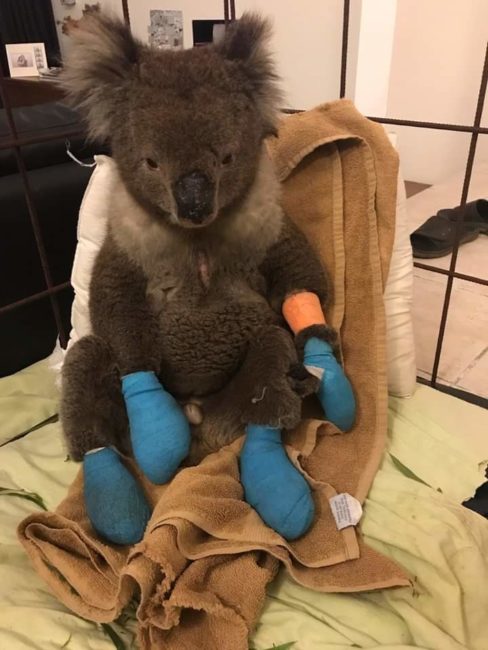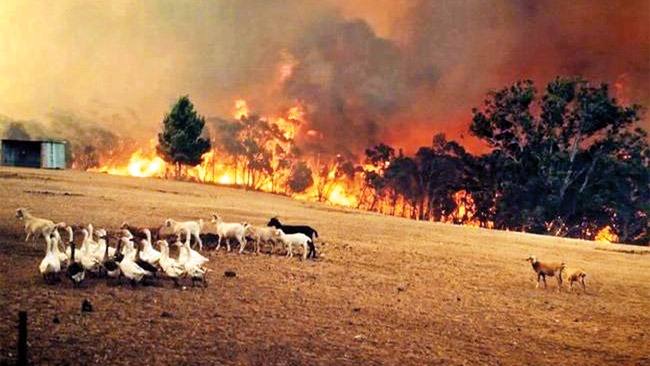Australia can no longer call itself the “lucky country”. An ancient dry continent now in ruins, suffering from the worst drought and bushfire season in history.
The latest data on the extent of fires shows more than 10.3 million hectares of land across Australia – an area the size of South Korea – has been razed by bushfires.
With no sign of the intense catastrophic fires subsiding, or the drought ending, the future for Australia’s unique biodiversity is grim indeed. A new designation as the ‘cruel country’ is more appropriate as we watch, in horror, apocalyptic scenes play out across the continent.
Adding to the tsunami of threats is a Prime Minister who believes in Armageddon, ‘speaking in tongues’ and the ascent of “good” people to the raptures, wherever they may be. A Pentacostal leader dedicated to ensuring the end times for Australia’s wildlife and environment. Morrison simply rejects the impacts of climate change, instead persisting in his oft repeated statement that the current bushfires are “normal for Australia”.
He has distinguished himself as the worst Prime Minister in Australia’s history. Morrison has ripped up environmental protections, ensuring his government “removes the green tape holding up developments”.
Unfortunately, PM Morrison is not alone in his insanity as the Premiers of NSW, Victoria, Queensland and South Australia are of the same mind. All continue to vigorously deny climate change impacts and any association between the catastrophic fires and drought.
The majority of states are in the hands of the arch right wing Coalition party, Queensland has a Labor government. Unfortunately, equally anti the environment. The current leader of the Labor opposition, Anthony Albanese, continues to support the massive Indian owned Adani coal project in the Galilee Basin, Queensland claiming that “coal and climate can live together.”
The impacts of the fire holocaust on wildlife are almost impossible to grasp. Professor Chris Dickman, an ecologist with the University of Sydney makes a conservative estimate that 800 million mammals, birds, and reptiles have perished. He says:
if you add bats, frogs, invertebrates in the death toll, over a billion would be a very conservative figure.
In what remains of Mallacoota township in Victoria, the beaches are covered in thousands of dead birds. Local bird experts have counted dead birds from over 25 species. Mallacoota is in East Gippsland which has been described as one of the richest areas anywhere in the state for birds. The ground parrot, the glossy black cockatoo, and the endangered eastern bristlebird have all been wiped out.

The loss of flying foxes has been equally catastrophic in NSW, Queensland Victoria. Many of the victims are young bats, unable to survive as there’s no blossoms or suitable food. The loss of key pollinators and seed dispersers will have much greater consequences when the fire season is over and rain comes.
In Adelaide Hills in South Australia, carers report 3,000 bats died in one day because of heat stress. Birds are falling out of the trees, their organs shutting down, blood oozing out of their mouths. Kangaroos and wallabies who have survived the fires are dying of thirst and starvation. Months ago, kangaroos and emus in outback Australia were dying in similar agony. Yet the governments have failed to cancel the commercial slaughter, the South Australian government offering wallabies as a substitute.

In the Warwick area, southwest of Brisbane, carers say that thousands of hectares of forests burned for nine weeks, killing the wildlife. They say that the Queensland government refused to send aerial water bombers – the only way to get to the fires – because it was “too expensive.”
Rescued koalas and other folivores brought into care can’t readily access release sites. Finding food and shelter from predators for survivors is and will continue to be an extremely difficult task.
Koalas and folivores have no alternative food source. Carers are forced to drive for miles to find the right leaves which contain nutrients and moisture. On Kangaroo Island, where the South Australian government claims 50,000 koalas (a highly inflated estimate), thousands of koalas and kangaroos have died in fires that have consumed over a third of the island.
On mainland South Australia, wildlife carers estimate 50% of the koala population has been killed by fires, heat and drought.

According to fire fighters, the fires have been so intense that the earth has burned down as far as 2 metres ensuring insects, beetles, worms, grubs, millipedes have been cremated.
Australia’s mammal extinction rate is the highest in the world according to the country’s Threatened Species Hub. Rampant clearing of native vegetation in NSW alone has jumped 800% in three years. An estimated half of Australia’s forest cover in the last 200 years has been logged and cleared. The intensity of the current fires has resulted in the loss of entire ecosystems.
According to the a senior research CSIRO scientist Australia’s bushfires are believed to have spewed as much as two-thirds of the nation’s annual carbon dioxide emissions in just the past three months, with experts warning forests may take more than 100 years to absorb what’s been released so far this season.
The concept of forests having any role in rain-making is completely foreign to the current dismal array of state and federal politicians.
National media has reported that 23 former fire and emergency leaders say they tried for months to warn Prime Minister Scott Morrison that Australia needed more water-bombers to tackle bigger, faster and hotter bushfires.
Former New South Wales Fire and Rescue chief Greg Mullins — one of the founders of the Emergency Leaders for Climate Action Group — said the group sought a meeting with the Federal Government to discuss the issue in April and again in May, immediately after the federal election. “We have tried since April to get a meeting with the Prime Minister,” Mr Mullins told ABC Radio. “It’s clear now we won’t get that meeting”. Currently, the governments have no plans or budget to address the biodiversity loss. It is highly unlikely there will be more than a few token efforts with any revegetation and repair work being left to the communities.
The bush will be silent. And the heavy cloud of mourning for what has been lost is a stone in the heart of all caring Australians. However, grief is transforming into massive public anger and the extraordinary flow of dollars to shelters from all over the world have put our wildlife on the global front page.
Australia is now the poster child for climate change impacts raising an essential question. Can a nation so badly hit recover its biodiversity and forests?
The MAHB Blog is a venture of the Millennium Alliance for Humanity and the Biosphere. Questions should be directed to joan@mahbonline.org
The views and opinions expressed through the MAHB Website are those of the contributing authors and do not necessarily reflect an official position of the MAHB. The MAHB aims to share a range of perspectives and welcomes the discussions that they prompt.

